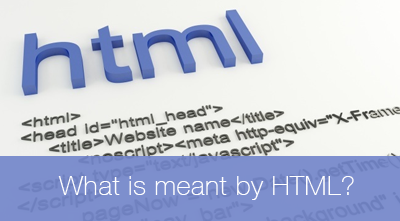What is HTML?
HTML is a markup language for describing web documents (web pages).

HTML stands for Hyper Text Markup Language, and is the most standard markup language available for creating web pages and web applications. HTML, along with its partners CSS and JavaScript, is the essence of everything that is built for the web.
This technology was built specifically for the World Wide Web, and it is seen as the most important building block for all pages and applications. HTML is written completely with text, rather than needing its own coding language.
HTML is typically identified by using tags around each element, with symbols such as “<” and “=” being commonly used. Many HTML labels include words such as “table”, “heading”, and more. While these HTML tags are a part of each and every website and web page, they are often hidden from the end user.
All the Details
HTML is the means of creating structured files, documents, and other parts of web pages in an easy and streamlined way. It is often defined by paragraphs and angle brackets to start and end a piece of script. Other sub-elements and factors can be written into HTML as well, which will help it to delineate what text is HTML and what text has other elements to it.
HTML can be written offline, without any requirement for an Internet connection. The coding process can be simple, and can be run through a compiler to make sure that there are no bugs during the coding process.
HTML with CSS and JavaScript
HTML works dynamically with CSS and JavaScript. CSS helps to define the aesthetic look and layout of a website or web page, while JavaScript controls the website’s behavior and interactive methods. The role of HTML is to embed these other scripts, such as those written in CSS and JavaScript, into the building block of the web page itself, ensuring that all of them will run smoothly.
Limits of HTML
While HTML is an essential building block, there are a few things it cannot do. For example, it cannot easily control the way websites look – while there is a way to control style with HTML, it is much easier now to use Cascading Stylesheets (CSS).
HTML tells a web browser what to show. Web browsers were created for the purpose of reading HTML documents, and then displaying them according to the code. By visiting any website, you are then viewing the HTML code (with possible implemented CSS and JavaScript) that has been written for it.
Things to Consider
There are basics to the fundamentals of HTML that help it run smoothly across all platforms. The basics include:
- Writing the skeleton of an HTML page
- Saving the code as an HTML file
- Setting the HTML code to view in a web browser
- Checking for any errors or bugs that prevent it from running smoothly
After the basics are understood, it is easy to start scripting with HTML. This code is essential to making web pages, and although new languages have been made to supplement it, there is nothing that can replace the important functions of HTML.